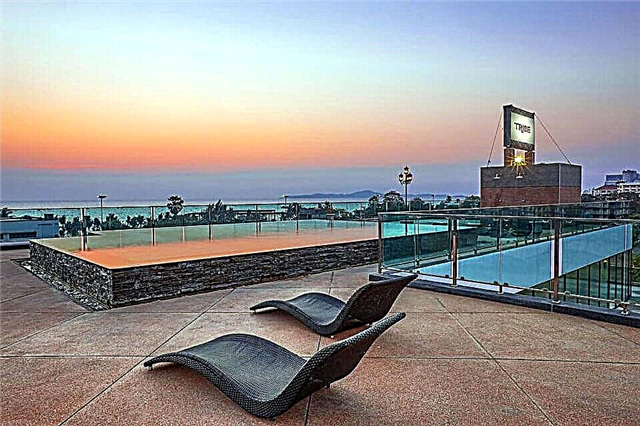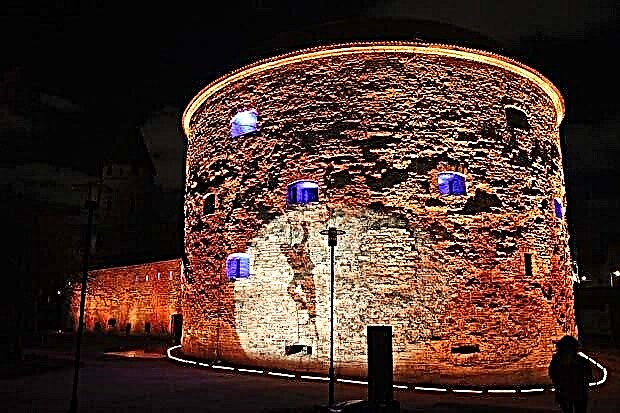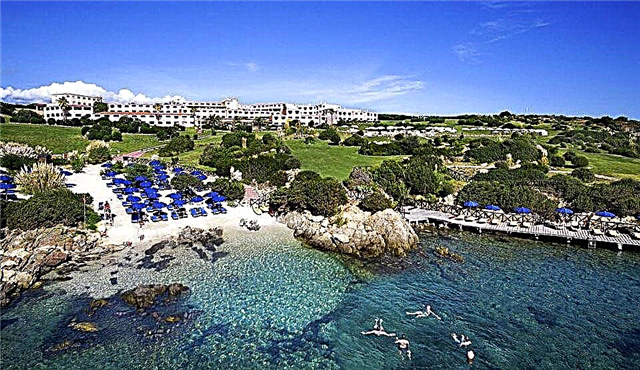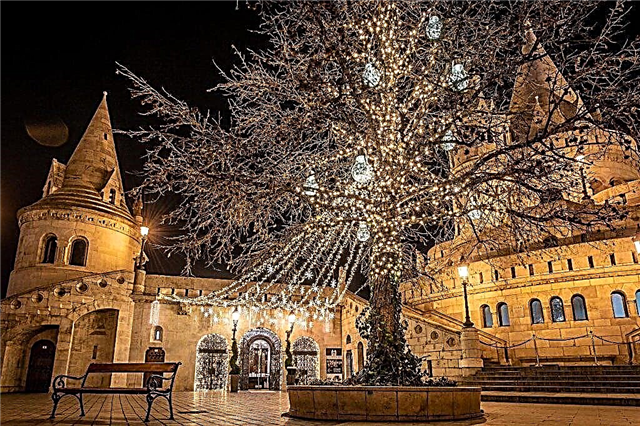Ancient Suzdal keeps many monuments of Russian architecture, and a special place among them is occupied by operating monasteries, many of which have stood on this land for over 700 years. Over the centuries, some Suzdal monasteries were used as places of imprisonment of representatives of the nobility, dissidents, sectarians and prisoners of war who were objectionable to the tsars. On their territory you can see ancient temples, unique wall paintings and icons. In some monasteries, rare museum collections are exhibited, revealing the pages of the history of the Russian state.
Spaso-Evfimiev Monastery
Article: Spaso-Evfimiev monastery - monastery-fortress

Spaso-Evfimiev Monastery from a bird's eye view
The Christian monastery was founded in the city by the prince of Suzdal and Nizhny Novgorod, Boris Konstantinovich, and this happened in the middle of the XIV century. The monastery stands on the high left bank of the Kamenka, from where ancient Suzdal opens in full view. This monastery was named in honor of its first abbot - the Monk Euthymius, a saint revered by all the people of Suzdal. The architectural monuments of the monastery are unique and have no analogues in Russian architecture, and therefore UNESCO included this monastery in the World Heritage List.
Initially, the monastery served as a fortress, designed to protect the city from enemies. And since the time of Catherine II it was used as a prison for dissidents. The Decembrist Fyodor Shakhovskoy, the fortuneteller Abel, several leaders of church sects and Old Believer priests spent their last days here. From 1923 to 1939, the monastery was turned into a political isolator, where Orthodox priests and opponents of Soviet power were serving their sentences.

View of the buildings of the Spaso-Evfimiev Monastery
Later, prisoners of war were kept within the walls of the monastery. In 1943, the German Field Marshal Friedrich Paulus, captured in the battle for Stalingrad, was in the monastery. After the war, the monastery was given over to an educational labor colony, in which juvenile criminals were kept. In the late 1960s, the monastery monuments were restored and a museum was opened here.
The main temple of the monastery, the Transfiguration Cathedral, was erected in the 16th century, and its architecture is traditional for the white-stone Suzdal architecture. Many travelers come here to see the unique frescoes preserved in this cathedral from the 17th century. Their authors are the famous Russian iconographers Sila Savin and Guriy Nikitin. The place of pilgrimage was also a marble crypt, installed over the burial place of Prince Dmitry Pozharsky.

View of the Pharmaceutical Garden of the Spaso-Evfimiev Monastery
The architectural monuments of the monastery, in addition to the main cathedral, also include the Church of the Annunciation, the Refectory Church of the Assumption and the Nikolsky Church. Every day, guests of the monastery can hear the melodic bell ringing, which bell-ringers arrange once an hour on the high bell tower. In addition to temples, tourists have the opportunity to visit the old prison building, where prisoners were kept from the time of Catherine II to the middle of the last century.
The monastery is located on pl. Lenin. Museums on its territory are open to guests every day, except Mondays, from 10.00 to 18.00.
Pokrovsky Convent
Article: Pokrovsky Convent

Pokrovsky Monastery from a bird's eye view
In the north of ancient Suzdal, on the right low bank of the Kamenka, the Intercession Monastery has been standing since the middle of the 14th century. It was founded by the prince of Suzdal and Nizhny Novgorod, Andrei Konstantinovich. There are many secrets and mysteries in the history of this monastery. The monastery "became famous" as a place of imprisonment of famous women of its time. The princesses and tsaritsa, daughters and wives of the most influential people of the Russian state served their sentences here.
Noble captives were sent to the Suzdal monastic prison not for atrocities or bad deeds. They were sent to the monastery when, for one reason or another, they became objectionable to the ruling sovereign.

View of the buildings of the Intercession Monastery
Since the fate of the unfortunates was predetermined in advance, wooden cells were built for them in the monastery, and the captives were buried in an underground crypt, under the monastery church.
The first noble prisoner of the monastery was Solomonia, the wife of the Grand Duke of Moscow Vasily III. The prince declared her incorporeal and sent her to a monastery, where the unfortunate woman was tonsured into a nun against her will. The daughter and niece of John III, the wife of Vasily Shuisky, John IV the Terrible and Peter I, the daughter of Boris Godunov, and also Princess Alexandra Cherkasskaya and Irina Nagaya lived out their days as disenfranchised nuns in the Intercession Monastery.

View of the Holy Gates from the Annunciation Gate Church of the Intercession Monastery
Since 1992, the monastery has been revived as a functioning women's monastery. Today it receives pilgrims and tourists every day. Many travelers who come to the ancient Russian city try to get to the territory of this monastery in order to see the beautiful Cathedral of the Intercession and the high tent-roofed bell tower. The snow-white stone church was erected in the 16th century with money donated to the monastery by the Grand Duke of Muscovy - Vasily III.
The monastery has also preserved the Holy Gates with the gateway church of the Annunciation and the Conception Refectory Church, built here in the 16th century. In addition, on the territory there is a loan house or a clerk hut, in the dungeon of which noble prisoners were kept. The monastery is located at Pokrovskaya Street, 43.
The Robe Deposition Convent
Article: The Monastery of the Deposition of the Robe - a monastic cloister with 800 years of history

General view of the Monastery of the Robe
The Monastery of the Robe is the oldest of the surviving ones in the Suzdal land. It was created in 1207. In addition to its venerable age, this monastery also holds other records. Its temples stand at the highest point of the ancient city. The largest bell tower in Suzdal (72 m) is also located here, thanks to which this monastery is visible from everywhere. The high building at the temple was erected in the classicism style in 1819 in honor of the end of the war with Napoleon's troops.
The history of the ancient monastery is closely intertwined with the fate of the Monk Euphrosyne of Suzdal. This Christian saint became famous as an ascetic nun and healer. According to the surviving legends, it was thanks to the prayers of Efrosinya that the army of Khan Batu, which destroyed Suzdal, did not touch the Orthodox monastery.

View of the Holy Gates and the Venerable Bell Tower of the Robe Deposition Monastery
As elsewhere in ancient Russia, until the 16th century, the monastery buildings were made of wood. The first stone church on the territory of this monastery was the three-domed Cathedral of the Robe. Later, a beautiful, richly decorated porch was attached to it.
With the advent of the new government, in 1923 the old monastery was closed. Bells were removed from his temples and sent to be melted down. Despite the fact that the Church of the Robe was considered an architectural monument, in 1929 a power plant was placed in it, demolishing the temple drums and domes. For forty years, the cathedral was constantly destroyed from the work of the power plant. In 1969, they finally began to restore it and the domes of the temple were returned to their original helmet-like shape. And since 1999, the monastery territory was returned to the church and transferred to the female monastic community. The monastery is located in Suzdal on the street. Lenin, 79.
Alexander monastery
Article: Alexander monastery
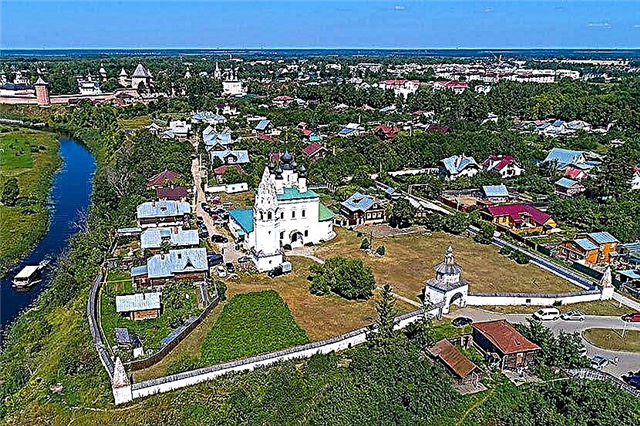
General view of the Alexander Monastery
According to legend, Prince Alexander Nevsky is considered the founder of the Alexander Monastery, and the date of the foundation of the monastery is 1240. For a long time this monastery was under the patronage of the Moscow princes and was called the "Big Lavra".But from those times, only two tombstones of the second half of the XIV century have survived, the inscriptions on which testify that the Suzdal princesses Maria and Agrippina found their rest here.
From the moment of its foundation, the monastery life did not calm down here until 1764, when, by decree of Empress Catherine II, the monastery was abolished, making the cathedral an ordinary parish church. And in 2006, thanks to the efforts of the Vladimir-Suzdal diocese, a monastic community re-emerged on the territory of the ancient monastery.

View of the Holy Gates of the Alexander Monastery
Today the oldest architectural monument of the monastery is the Church of the Ascension of the Lord with a bell tower, which was built at the end of the 17th century with money from the mother of Peter I - Tsarina Natalia Kirillovna. The Church of the Ascension is very beautiful. It consists of a cubic two-tiered four, topped with five graceful chapters. The windows of both tiers are decorated with picturesque carved platbands.
Nearby, the tent-roofed bell tower has an octagonal pillar at its base. Its walls are practically not decorated, which makes this bell tower unique among other monuments of Russian architecture of ancient Suzdal. From the stone fence that once surrounded the monastery territory, only a small fragment and the Holy Gate, restored in 1947, remained.
The monastery is located behind the Pokrovsky bridge, on the left bank of the Kamenka, on the street. Gastev.
St. Basil's Monastery
Article: St. Basil's Monastery

General view of the St. Vasilievsky Monastery
Near the road leading to Kideksha, on the eastern outskirts of the city, there has been a Vasilievskaya monastery since the 13th century. The times when it was created were turbulent, and the monastery was built as an outpost of the city's defensive structures. According to legend, this monastery arose on the site where the first oak temple of Suzdal stood before it, in which Vladimir Krasnoe Solnyshko baptized the townspeople.
As an independent monastery, the monastery existed until the 60s of the 18th century. And later, when many of the monastic territories were liquidated, it was assigned to the Spaso-Euthymius Monastery. Today, almost the entire monastery complex belongs to the male monastic community.

In the foreground is the Church of the Presentation of the Lord, in the background is the Cathedral of Basil the Great, St. Basil's Monastery
Pilgrims and tourists come here to see the unusual Vasilievsky Cathedral, built in the 1660s. Previously, this temple was three-domed, but today it is crowned with one dome. The design of the cathedral's facades is so laconic and austere that the temple looks more like an old fortress. In addition to him, the refectory church of the Presentation, a stone fence, the Holy Gates and some other buildings that are now occupied by monks have been preserved on the territory of the monastery. Picturesque spaces of Suzdal are perfectly visible from the monastery bell tower.
The territory of the monastery is located on Vasilievskaya Street.


